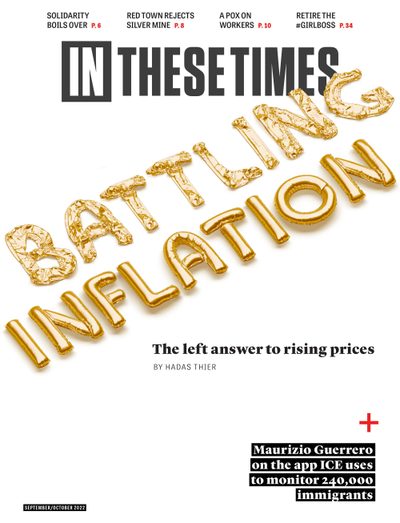Frustrated With #GirlBoss Feminism? Look to Eastern European History
In Red Valkyries Kristen Ghodsee interrogates the false promise of liberal feminism.
Brianna Di Monda

Women continue to make less than our male counterparts, still don’t have guaranteed paid family leave and, in June, lost the constitutional right to an abortion. It’s become increasingly clear the version of feminism that only empowers women within the status quo economic structure of capitalism — sometimes called “liberal feminism” — isn’t serving working-class Americans. Time and again, our country is failing us.
How, then, can we move forward?
Kristen Ghodsee, a professor of Russian and Eastern European studies at the University of Pennsylvania, offers a unique response: Look at the history of socialist feminism in Eastern Europe.
In Red Valkyries: Feminist Lessons From Five Revolutionary Women, out now with Verso Books, Ghodsee highlights five socialist women prominent in the 19th and 20th centuries who sought to reimagine the power structures that seeded inequality. The book features Alexandra Kollontai, an activist who toured the world advocating for women’s rights under a socialist framework, deemed a national security risk by the United States. There’s also Lyudmila Pavlichenko, who remains the most accomplished female sniper in history with 309 fascist kills. Together, the five women are emblematic of an alternative history of the women’s movement — one the United States has dismissed due to its anticapitalist rhetoric — that is essential to understanding today’s fight for women’s liberation.
I spoke with Ghodsee about the narrow focus of #girlboss feminism typified by Sheryl Sandberg, the growing support to recognize unpaid care work, and the fallacy of American freedom.
Brianna Di Monda: Early in Red Valkyries, you make a point to distinguish between liberal feminists and women’s activists. You outline the bourgeois associations with the word “feminist” in Eastern Europe, saying socialists perceived those who called themselves feminists as representing the interests of the “upper ten thousand.” For those who haven’t yet read Red Valkyries, can you begin by speaking about this distinction?
Kristen Ghodsee: I think the key distinction between what people sometimes call the “bourgeois feminists” and the socialist women’s activists is that feminist demands originated among women of the more privileged classes who were barred from attending male institutions of higher education, shut out of male professions, denied the franchise and forced to turn over all of their property upon marriage.
So the wealthy heiress of a British industrialist had very few rights compared to her brothers and had little control over her own life, since long-established legal institutions rendered her the property of her father before she became the property of her husband. Feminists like the suffragettes in the United Kingdom not only wanted the right to vote, but they also wanted to pursue liberal professions and to retain rights to their inherited wealth upon marriage. Obviously, these types of demands only applied to women wealthy enough to own property or to pursue higher education. The vast majority of working-class women cared much more about basic bread-and-butter economic issues, like being paid a fair wage and having job protections for maternity.
And did these liberal feminists intend to uphold the capitalist status quo? Or were their bourgeois ties an unconsidered and comfortable association?
Whereas the feminists were willing to work within the framework of industrial capitalism (as long as they enjoyed equal access to the wealth it created), socialist women’s activists were critical of capitalism and demanded radical changes to ownership structures. Whereas the feminists largely focused on achieving the equality of men and women within the existing system, the socialist women wanted to overturn the system to make a better world for all members of the working class. Some bourgeois women acknowledged the problems with their focus on wealthy women, but they argued for a trickle-down strategy — that, if wealthy women had access to equal rights with men, then these gains would ultimately trickle down to working-class women. The problem with this point of view is that poor people are no better off if working men and women are equally poor.
In America, was working within the capitalist system the only way change could be effected? I imagine the second-wave feminists didn’t want to be associated with socialism during the Cold War and didn’t see it as a viable way to fight for women’s rights in this country.
In the U.S. context, there were initially many different kinds of feminists during what is called the Second Wave, although that term hides the efforts of the many communist and socialist women advocating for women’s rights in the 1930s and 1940s, before they were attacked by the House Un-American Activities Committee (HUAC) and the likes of Joseph McCarthy. In fact, after WWII, an organization called the Congress of American Women was the U.S. affiliate of the Women’s International Democratic Federation, a large leftist international organization founded in Paris in 1945. During the second Red Scare, HUAC accused the Congress of American Women of being a “communist front” organization, and it was disbanded with many of its leaders persecuted and ruined.
After these experiences, many U.S. feminists understood they needed to be willing to advocate for their rights without challenging the prevailing economic status quo. There were important exceptions to this tendency — such as women like Angela Davis and Florynce Kennedy — but in general, it was the liberal feminists, around organizations like the National Organization for Women, who ended up dominating the Second Wave, because they presented few challenges to capitalism.
You cite the new Ms. Monopoly game, which updates the famous boardgame with a woman mascot, saying its design mirrors Sheryl Sandberg’s “lean in” feminism, “whereby women win the game by becoming ruthless monopolists just like their male competitors.” How did the contemporary image of the feminist become a white striver using the system to acquire, rather than dismantle, patriarchal power? Were the associations of the word “feminist” in Eastern Europe similar to today’s associations with the term “girlboss”?
Yes, East European women’s activists often criticized Western feminists for focusing their advocacy efforts on the achievement of full equality with men within a world defined by both capitalist and patriarchal norms. What we call “girlboss” or “lean in” feminism is exactly this narrow focus on ensuring that there is gender balance in the C-Suite or on corporate boards without critically thinking about how the whole existence of private corporations impacts the lives of ordinary workers, including corporate power’s role in perpetuating structural sexism and racism.
Nancy Fraser has a wonderful article in the New Left Review, “Feminism, Capitalism and the Cunning of History,” that details the political processes of how this situation came to be. Fraser argues that U.S. Second Wave feminism originated with an attempt to launch a variegated critique of “androcentric state-organized capitalism,” which focused on “three analytically distinct dimensions of gender injustice: economic, cultural and political.” Over time, capitalism was able to divert and ultimately co-opt the energies of the various feminist movements for its own ends so that, now, the popular image of a feminist is a white woman corporate executive who can slay the boardroom. This is the logical conclusion of the strand of “bourgeois” feminism which began in the late 19th and early 20th centuries, with a primary focus on shattering the glass ceiling for women of the already privileged classes.
You describe socialist activists as a group that “challenged the underlying system that created and legitimated the unequal distribution of privilege to begin with.” Do you think we’re beginning to embrace some aspects of socialism in the United States with our calls for extended maternity leave, subsidized childcare and universal healthcare? It seems we’re finally asking for resources, rather than privileges, to ensure equality. Do you think this will last? I’m thinking, too, of Alexandra Kollontai, an aristocratic Bolshevik covered in your book. After she first visited the United States, she wrote an essay on the Statue of Liberty: it shrinks before Wall Street skyscrapers, embodying how the American promise of freedom comes second to corporate interests.
I would love to think that it is socialism that is animating contemporary discussions about extended paid parental leaves, subsidized childcare and some form of universal healthcare, but I’m more cynical about American political and economic elites. Corporations care about profits, and they know their profits will be threatened if people decide to stop having babies.
As pointed out by theorists like Silvia Federici so many years ago, the unpaid private labor of social reproduction (still largely performed by women in the private home) provides a huge subsidy for capitalism. Because of our hyper-individualistic culture and the idea that starting a family is a private decision and responsibility, parents provide a valuable good — the next generation of workers, consumers and taxpayers — more or less for free to society. The production and maintenance of this next generation is a huge public good, but the costs are largely born privately.
If millennials were still willing to start families and raise children as their parents and grandparents, few politicians would be seriously considering socialist-sounding ideas. But birth rates are declining steadily throughout the industrialized world and this is a threat to the long-term survival of capitalism. Since more than two-thirds of U.S. gross domestic product is consumption, who is going to buy all of the crap that capitalism overproduces if there are fewer and fewer consumers in the future? It is therefore a fear of demographic collapse, combined with growing xenophobic and white supremacist anxieties about immigrants and minorities, that is fueling new conversations about public support for socially reproductive labor.
A throughline between the five women discussed in Red Valkyries seems to be recognizing the “incompatibility of American claims to upholding democratic freedoms with their poor record on civil rights.” Do you think the U.S. positing itself as “the land of the free” actually hurt the U.S. women’s movement? We were insistently told we were free when, in fact, we had fewer rights in the 20th century than our Eastern European counterparts. For example, Russia gave women the right to vote in 1917, formed coeducational schools in 1918 and legalized abortion in 1920.
Yes, American women were constantly gaslit by political and economic elites who said they had it so much better because they enjoyed “freedom” rather than equal rights or economic justice. American leaders defined “freedom” in a particular way that often excluded possibilities for the expansion of public services to support socially reproductive labor. Americans are generally free to be unemployed, free to be homeless, free to take on Himalayan amounts of student debt and free to go hungry, because they don’t have the so-called nanny state interfering with their ability to make decisions about their own lives. Of course, that also means Americans should be fully free not to start families if it makes it easier to survive in a society with few social safety nets, which is exactly what many are doing. I don’t think it’s a coincidence that reproductive rights are now under attack at the exact moment economic elites are worried about declining birth rates.
The end of your book leaves readers with nine tips for what we can learn from these activists, including the importance of remaining politically engaged, committing to lifelong autodidacticism and making time for rest. Which of these is most important for you, personally, to do next? Has completing Red Valkyries inspired you to start a new project? Or is this simply a time of rest and celebration as your book comes out?
Alas, although I need the rest badly, I have one more book-length project I want to finish. I feel like, now more than ever before, we need to embrace utopian visions for the future, especially as regards the family. So, I want to do a big survey of two-and-a-half millennia of utopian thinking about the private sphere. Only when that’s done will I grant myself some much needed repose, not just as an exercise in solipsistic self-care, but as a necessary recharging of the energies necessary for the many struggles to come.
This conversation has been edited for length and clarity.
Red Valkyries: Feminist Lessons From Five Revolutionary Women is on sale now from Verso Books.

I hope you found this article important. Before you leave, I want to ask you to consider supporting our work with a donation. In These Times needs readers like you to help sustain our mission. We don’t depend on—or want—corporate advertising or deep-pocketed billionaires to fund our journalism. We’re supported by you, the reader, so we can focus on covering the issues that matter most to the progressive movement without fear or compromise.
Our work isn’t hidden behind a paywall because of people like you who support our journalism. We want to keep it that way. If you value the work we do and the movements we cover, please consider donating to In These Times.
Brianna Di Monda is an editor for the Cleveland Review of Books. Her fiction and criticism have appeared in The Brooklyn Rail, Worms Magazine and Full Stop, among others.




